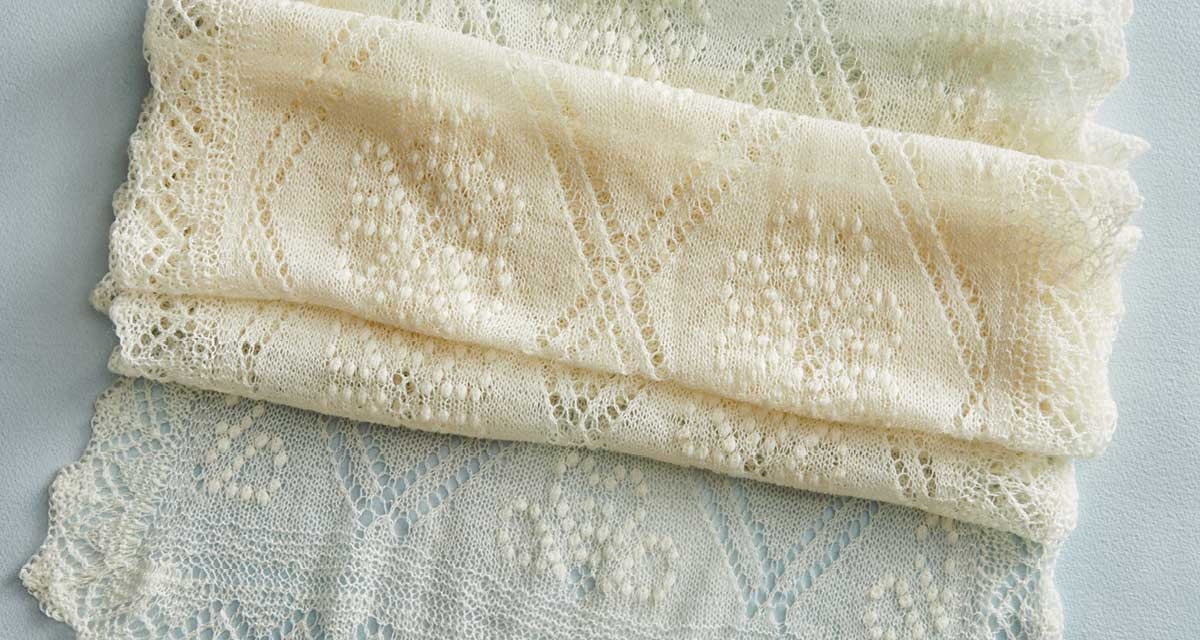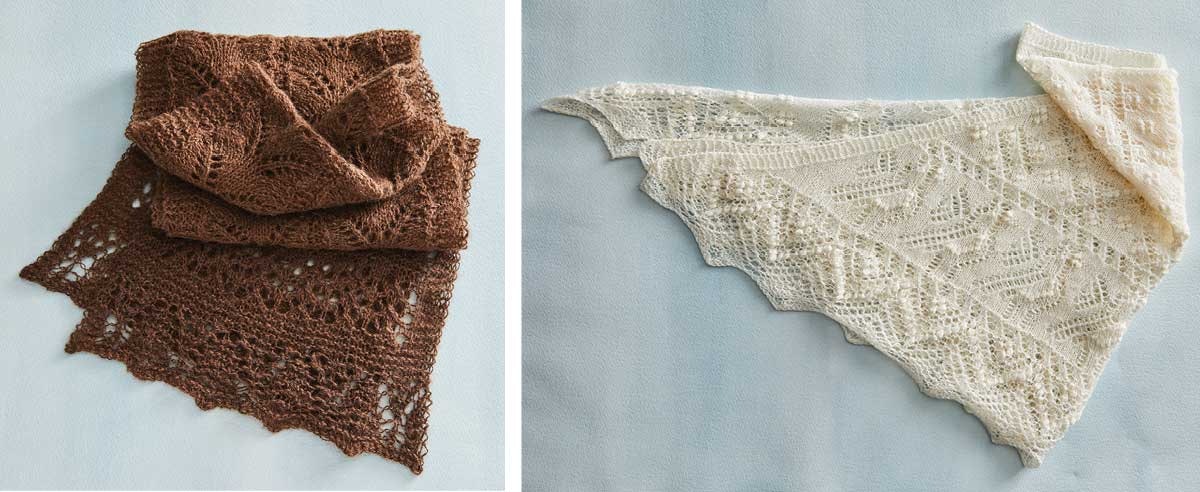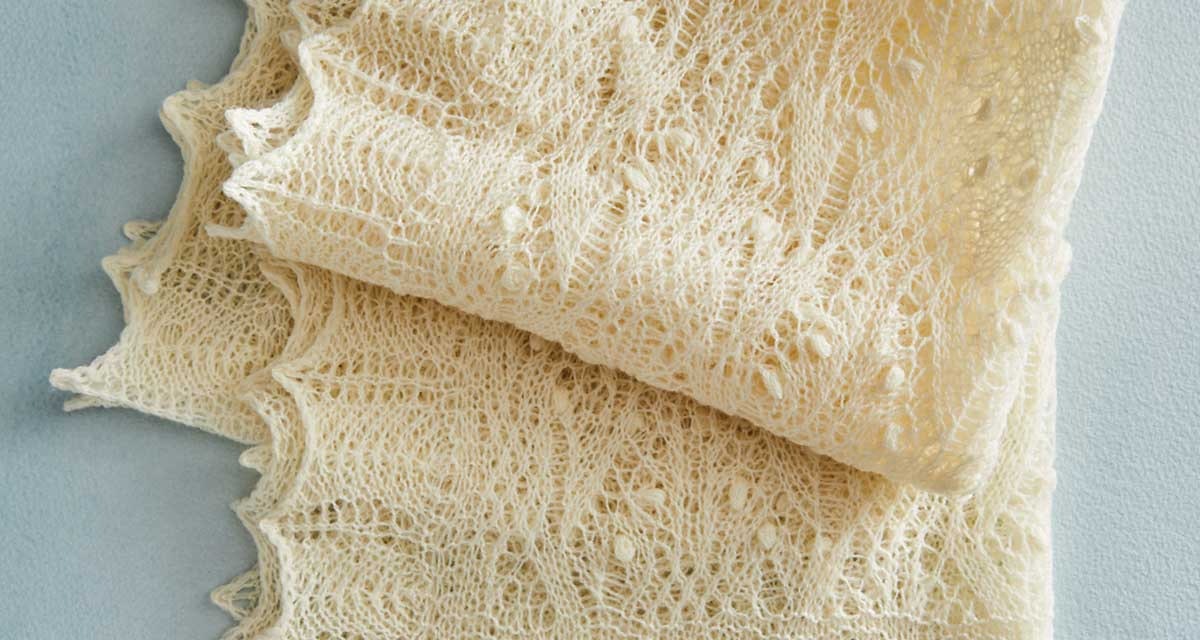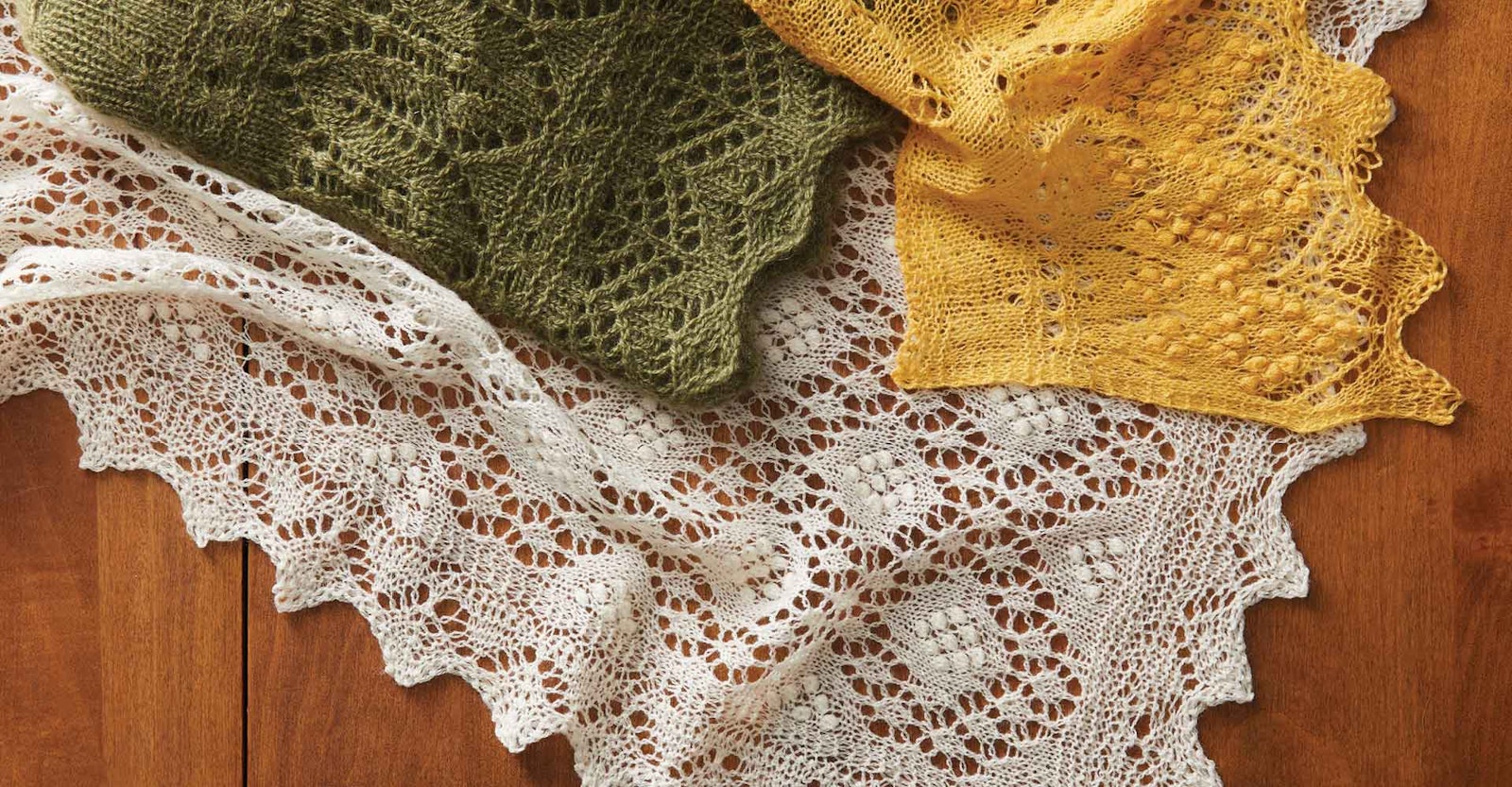During a trip to Haapsalu, Estonia, in the summer of 2018, I visited a delightful exhibition at the Pitsikeskus (Lace Center). The inspiration for the exhibition, The Definition of a True Haapsalu Shawl, was the way so many visitors to the center would walk in and, noticing a lovely scarf or other item in the shop, comment, “Oh, look, a Haapsalu shawl.” Often, the item was actually neither a true shawl nor a true scarf but a variation in some form of one of the exquisite lace items that have their origins in Haapsalu. (Note: In the “lace language” of Estonia, a scarf is a square or triangle; a shawl is a rectangle.)
The exhibition fascinated me: I studied the items displayed and took many notes. After talking with the knitters there, we decided that these items would be considered “rebellious,” which is important in defining those that are “true.” In the process, I realized that many of the items I have made over the years using techniques from Haapsalu fit, as the exhibition indicated, the description of rebellious lace. Below are some of the characteristics associated with both true Haapsalu shawls or scarves and rebellious ones. Both are important to keeping the 200-year-old heritage of making Haapsalu shawls and scarves alive.

This rectangular shawl knitted by Virvi Palmiste incorporates the Greta Garbo pattern and is an example of a “true” traditional Haapsalu shawl. Collection of Nancy Bush.
True Haapsalu Lace
- A true Haapsalu shawl or scarf is always made of 100 percent wool. Although other fibers can make a lovely and traditional-looking shawl or scarf, 100 percent wool is firmly part of the tradition. Typical yarn weights are 28/2 (1,400 meters [1,531 yd] in 100 grams [3.5 oz]), 30/2 (1,500 meters [1,640 yd] in 100 grams [3.5 oz]), and 32/2 (1,600 meters [1,750 yd] in 100 grams [3.5 oz]). All are two-ply yarns.
- • The yarn used to make a true Haapsalu shawl or scarf is always a solid color. The color can be dyed bright or pastel or a natural sheep’s color, but there is never more than one color in a true Haapsalu shawl or scarf.
- A square scarf always has a large decorative border, a center that usually has a repeated overall pattern, and a separately knitted and sewn-on scalloped lace edge. The scarves are often about 40 inches by 40 inches (102 by 102 cm or 1 meter by 1 meter) square.
- A rectangular shawl usually has one pattern that repeats and always has a separately knitted and sewn-on scalloped lace edge. A few shawls contain several motifs in the center, but this design is not as common. Shawls typically measure about 20 inches (51 cm) wide by 70 inches (178 cm) long.
- Triangular scarves are made three ways. The earliest construction method, developed in the 1930s, involves knitting from the top down, beginning with a scalloped-lace edge. The center is then decreased on each side, to the tip. The outer-lace edge is knitted separately and sewn on. The result is a lace edge on all three sides. The second construction method involves knitting from the tip up with a garter-stitch border at the top and a separately knitted and sewn-on lace edge on the two sides. The third starts at the outer sides by casting on for the lace edge. The body of the scarf is then decreased in three places: across every right-side row, at each side edge with a single decrease, and in the middle with a double decrease, removing four stitches on one row. The shawl is completed at the center of the upper edge with a grafted seam.
- The center of all true Haapsalu shawls and scarves is always surrounded by a garter-stitch frame. The outer-scalloped edge, knitted separately and sewn on, is attached to this frame.
- The patterns used in Haapsalu shawls and scarves can be traditional or be newly designed, but they all have at least a basis in tradition. Many include the unique technique found in Haapsalu lace—the nupp (Estonian for “button,” “bud,” or “knob”), a bobblelike feature that creates texture and added interest to the openwork patterns. Many patterns, whether traditional or newly designed, are inspired by nature.

Left: The Prairie Scarf, designed and knitted by Nancy Bush with bison yarn handspun by Judith MacKenzie, is another “rebellious” example. Instructions for making it are in All New Homespun Handknit: 25 Small Projects to Knit with Handspun Yarn (Fort Collins, Colorado: Interweave, 2009). Right: There are three ways to make a triangular scarf. For this scarf, Siiri Reimann used the third method to knit this scarf with the Lääanemaa’s Bird pattern, illustrating that a recently designed pattern that uses traditional elements and techniques is also a “true” traditional Haapsalu shawl. Collection of Nancy Bush.
Rebellious Haapsalu Lace
- A rebellious shawl or scarf may be made of a blend of wool and other fiber(s) or another fiber altogether, such as linen, mohair, silk, or alpaca. The exhibition included a triangle in a lovely yellow mohair of varied tones; it was perfectly made, but the mohair fiber and varied tones make it rebellious.
- The weight of the yarn can be thicker than the classic fine yarn used in Haapsalu. The exhibition included a triangular scarf knitted (using the third construction mentioned above) in a worsted-weight yarn. The scarf was enormous, closer to a blanket, making it much more than a scarf.
- A rebellious scarf or shawl may be an unusual shape, not the traditional square, rectangle, or triangle. Examples of such variances include the accompanying project, a pelerine, with its short lacy bolero style and the interesting half-moon shape of Susanna IC’s Annis Scarf. Knitters in Haapsalu discovered the Annis Scarf on the internet, adapted the shape, and added motifs and different lace edges to create something special within their own tradition. Other rebellious shapes include cowls, irregular-sided squares, rectangles, or triangles.
- More than one color in a shawl or scarf makes it rebellious. A perfectly constructed Haapsalu shawl with a scalloped-lace edge in a different color from the center (for example, a white center with a dark blue outer edge) is rebellious. In a perfectly constructed Haapsalu-style shawl, the yarn may be dip-dyed or tie-dyed or spun using mixed-colored top or roving, making it rebellious, as would extra colors added in the patterning or nupps made with a second color.
- A shawl or scarf is rebellious if the scalloped-lace edge is made in any way other than the traditional “knitted separately and sewn-on” method. If the outer edge is picked up and the lace edge knitted on, the piece is certainly rebellious. Although you can achieve a scalloped-lace edge this way, the points are not as rounded, so this approach is not considered the “correct” way to make the lace edge. As Aime Edasi and Siiri Reimann explain in The Haapsalu Shawl (Türi, Estonia: Saara Publishers, 2009), “The lace edge is not picked up and knitted onto the shawl, as there would then be yarn-over holes in the center of each scallop on the outer edge, which would spoil the shape of the points.” The exhibition also contained a lovely shawl with a Greta Garbo pattern in which the outer edge was completely replaced by slightly felted wool fleece, similar to a Santa’s beard!
- Beads, as well as other embellishments, denote a rebellious shawl or scarf. One scarf in the exhibition was embellished with needle-felted bits of colored wool fiber and another was embellished with added flowers, some knitted and some made of organdy. Replacing nupps with beads is also considered quite rebellious.
- Mixing two traditional patterns that would normally be used individually in one shawl or scarf is considered rebellious, even if all the other criteria for a true Haapsalu shawl are met. The exhibition contained a shawl with the Lily of the Valley pattern and a leaf pattern used together in stripes. Another shawl, made of Jamieson and Smith’s cobweb-weight wool yarn, contained cross-stitch motifs adapted from an embroidery pattern that were made with nupps. The effect was quite heavy, not airy and lacy.

Hilja Aavik’s “rebellious” shawl features a picked-up and knitted-on edge. The center pattern is the Pasqueflower Pattern 2 in The Haapsalu Shawl by Aime Edasi and Siiri Reimann (Türi, Estonia: Saara Publishers, 2009). Collection of Nancy Bush.
The knitters in Haapsalu are very skilled. They love making their traditional shawls and scarves, but they also love trying new things, exploring interesting ideas, and creating new designs. On display in the Pitsikeskus shop, one might see an exquisite, but definitely “rebellious,” dress decorated with traditional Haapsalu lace patterns made with linen yarn. The knitters are pleased to make and sell lovely lace pelerines like the accompanying project or scarves inspired by the Annis Shawl from Susana IC in the shop. Although these items are rebellious, they also fit into the innovation and growth of this 200-year-old cottage industry.
Nancy Bush continues her fascination with Estonia and their lace knitting. She travels to Estonia regularly, always finding something new to catch her attention. The author would like to thank Michelle Poulin-Alfeld for invaluable help with the “architecture” of the pelerine and her great cast-off solution, and Lisa Sewell and Sheryl Gillilan for the loan of their lovely pelerines from Haapsalu.
This article originally was published in the Winter 2019 issue of PieceWork.

